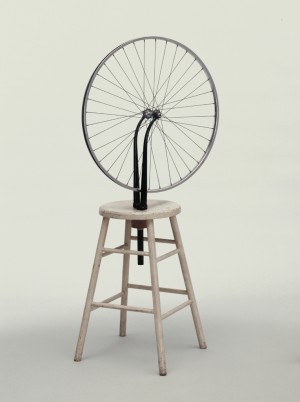Kinetic art is art that moves. The motion can be physical, achieved by motors, gravity, wind, the sun or the viewer. The motion can also be purely visual, for example through geometric patterns that appear to move, or through the use of film, lights or computer animation. In addition to movement, this art form can make use of light and/or sound which means that it appeals to more of the senses than traditional art forms. Kinetic art often invites the viewer to interact, for example by setting the work in motion by pushing a button or turning a handle.

Although it did not become a formal art form until the 1950s, the historical roots of kinetic art can be traced back to the beginning of the 20th century to works like Marcel Duchamp’s Bicycle Wheel (1913), credited later with being the first kinetic sculpture, and Naum Gabo’s Kinetic Construction: Standing Wave (1919-20). Laszlo Moholy-Nagy’s Light-Space Modulator (1930) was an early motorized rotating sculpture of metal, glass and light beams.
The development of the kinetic art form was punctuated by a handful of seminal exhibitions, including Mouvements in Paris in 1955, and Labyrinth at the 1963 Paris Biennale where the Groupe de Recherche d’Art Visuel (GRAV) presented several types of kinetic and optical art. Kinetic art made its formal debut in Norway in 1968 at the exhibition Light and motion in Kunstnernes hus, curated by Morten Krogh, featuring, among other artists, Irma Salo Jæger and Odd Tandberg. Henie-Onstad Art Centre followed up the next year with the retrospective exhibition Julio le Parc, highlighting the Argentinian artist’s work with light, reflection and interaction, and also hosted the major Jean Tinguely exhibition The Future as We Remember It in 2009. Swiss-born Tinguely is considered a major figure in kinetic sculpture with his self-drawing machines, huge moving sculptures of industrial scrap and his artistic ‘happenings’ which sometimes ended with his artworks exploding or burning up.
In Norway, Odd Tandberg was a pioneer in the use of acrylics, rotating discs, lasers and sound-driven light. Bjørn Melbye Gulliksen has created machines that produce random complex images, and fantastical ball bearing machines inspired by higher mathematics and carnival games, but always in the service of a deeper meaning.

Kinetic art has always maintained a close relationship with technology, science and more recently, ecology. Sometimes, like in the works of Moholy-Nagy and Tandberg, the art treats the machinery of the time (or an earlier time) with curiosity and respect. Moholy-Nagy went as far as to say that, “the reality of our century is technology. […] To be a user of machines is to be the spirit of this country. Machines have replaced the transcendental spiritualism of past eras.” Conversely, some kinetic artists have used their work to raise critical issues about technology and society at large. Tinguely satirized mass-produced consumer products, and said “to me art is a form of manifest revolt, total and complete.” One characteristic of some kinetic artworks, though far from all, is a whimsical or humorous treatment of serious themes, which can be an effective invitation to reflection and discussion.
Interest in kinetic art peaked in the 1950s and 1960s, and fell somewhat out of fashion as video, computer animation and robotics became a bigger part of popular culture and art.
More recently, many group exhibitions in Norway have featured one or more kinetic works. Norwegian Sculpture Biennial 2011: Humanity and Machine, and NOR13: Lydbasert kunst come to mind, but it was not until 2015 and 2017 that Norway had the first exhibitions of purely kinetic art by artists living in Norway. In 2020 the world’s first live, remote-activated online exhibition of kinetic art was held on kineticart.no.
The fact that kinetic art often features interaction, and sometimes humorous treatment of its themes, contributes to its enduring popularity, particularly among children and the young at heart. However, these very characteristics, coupled with the novelty and technology of the art form, runs the risk of distracting some viewers and critics from a deeper analysis of the works.
A dedicated core of young and older artists is continuing the tradition of kinetic art today, with many showing a preference for mechanical and electrical processes instead of digital, perhaps partly as a nostalgic and tactile reaction to our increasingly digital and virtual lives.
This renewed interest is visible not only in Norway, but internationally in, for example, the Ghosts in the Machine exhibition at the New Museum in New York in 2012, the MIT Museum’s 5000 Moving Parts from 2013-2015, the annual Kinetica Art Fair in the UK, the large annual International Kinetic Art Exhibit and Symposium in the USA, and Norway’s own Meta.Morf Bienniale in Trondheim.
Text: Glen Farley

